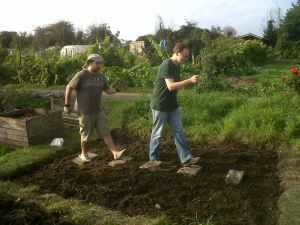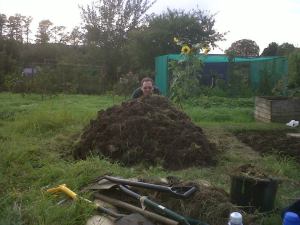Well if only if it was easy as saying it, beating the weeds seems to be an endless task. Hence this post will be a bit long winded, so I will write a shorter version, with less personal information too. In the last 4 years I’ve started in 5 new growing spaces, so I know a lot about how to start, but I’d have to say my methods are not so tried and tested as I’ve not always been around to see the results. So to begin this I will mention a bit about my gardening history, this is also mentioned in my intro blog, so sorry if its repetitive, I just wanted to catch up anyone who hasn’t read that.
I’ve lived in London since 2001 and never really had a garden, or at least one that I felt was mine to do something with. I started dating Simon around 4 years ago, at the time my balcony was put to good use growing tomatoes, salad and herbs, this was the most growing I’d done in a long time. I can’t say things flourished on there, as it did seem windy up there, and I had a neighbour downstairs who once or twice got annoyed when I watered my plants, as the water dripped through to her balcony. Simon was involved in a community permaculture group, so of course I went along and I enjoyed having a bit more growing space and freedom. We also began a bit of guerilla gardening, sowing a few crops in the communal gardens that my flat was in.
After around 6 months doing the permaculture we were told the site we’d been working on, was no longer ours and we were giving a new one to work with. The new space being under some trees in a woodland and also to be shared with some bee-keepers. It was far from ideal and we were a bit dispirited that we’d lost our original growing space, that we’d put a lot of effort into. By now Simon had moved in, and it was further away from us both. Then luck struck out and I managed to get an allotment. So a year on we’d sadly given up the permaculture group. The communal garden patch hadn’t really taken off as the cats used it as a loo, and we were loving the allotment. So we decided to take on a second plot, surprisingly there was good availability so we didn’t feel bad to have two. The weeds were the worse in this one, with lots of mares tail.
And then a few months into the new giant sized plot, we decided to move house. In the end London was too expensive, so we moved just outside of London to a house with a much bigger garden than we could have hoped for. We weren’t sure if we should keep the plots or not, but in the end we decided it didn’t make sense to drive all that way, when we had a good sized garden to use.
So what have I learned from starting over so many times? Well basically it’s hard work and really I’m yet to see if I can tackle the weeds, but I can see I have improved the soil structure, which is half the battle. And certainly the weeds are getting less and less. So how do you start, you’ve moved into a new house and you have lots of other things to do, but you don’t want those little weeds to turn into a jungle as you unpack- how do you cope? Do you resort to using chemicals or do you prefer to do it naturally? Or perhaps your new allotment is already a jungle and you don’t know where to start.
So what is a weed? I’ll always remember a headteacher telling us this at school, but I think its a famous quote as well. “A weed is a plant in the wrong place” so some things that are a weed to one person may be a pretty flower to another. To some people nettles are a nuisance, they sting, they grow where you don’t want them, but to another person the leafs are a delicacy- have you tried nettle tea, nettle soup, nettle risotto? If you haven’t please do- they loose their sting upon a short amount of cooking. Dandelions roots can be used to make coffee (I’m yet to try this) Cleavers or sticky willy can be used as a tea, Comfrey is great to use as a plant feed. So one mans weed is another mans treasure, so as you get rid of the weeds, do consider if they have other uses.
Also some weeds are perennial, which means they will come back every year, these are the hardest to remove. Some seeds will spread lots of seeds, and when the conditions right they will grow back. Some will grow back from the slightest bit of root left in the ground. But one things for sure if you leave the ground bare for any length of time weeds will start to grow. So be it mulch or plants get the ground covered with something ASAP after weeding.
One method that I’ve found to work is mulching with cardboard. If you have no time either flatten the weeds or pull out if you have more time and then add flattened cardboard boxes over the top and hold them down with bricks, stones, pieces of wood whatever you can get your hands on. Try and let as little light get to the weeds as possible. Like this you can leave it for several months, though in winter the boxes may disintegrate and need replacing. When you’re moving, you’ll likely have a lot of boxes, if not the supermarkets will usually give you some if you ask nicely. We’ve had a couple of midnight trips to Asda’s to get boxes. After a while the boxes tend to stay down, but do make sure they are secure and try and cover even the smallest gaps, as the weeds will find them.
What if it’s mostly grass and very little if any weeds? The method we used for this was a turf mountain. We marked out our bed and then cut the top inch or so off the soil with the grass attached and then stacked the turfs upside down in a big stack. Cover the stack with cardboard, you can also add manure if you want. After around 2 years it will have rotten down and you can then use as compost. We grow potatoes and squash in the pile. Just try and block out the light from any potential weeds.
For something like Dandelions it can be time consuming to remove the roots, but this is the best method to get rid of them, but if you only have a few minutes, the best thing to do is to remove at least the flower, but also any leafs if you can. Removing the flower will stop it spreading seeds, removing the leafs will weaken it. Also do this for any other unwanted flowering weeds and plants.
When weeding I like to have a few containers handy to help me sort out the various bits. Ideally you’d have 4 containers, or maybe 1 big one which you can sort later. So what are the bits. Firstly there is the normal annual weeds which can be added to the compost heap straight away. Then there is the stones, most soils contain stones, and certain crops don’t like stony ground, so if you can remove them as you go, it will be handy and you may be able to use the stones in another project, such as a drainage hole. The third container is for any rubbish you find from bits of glass and wire to rusty old tools, it’s amazing the rubbish you’ll find. And lastly a container for perennial weeds, this is the nastier of the weeds and you want to make sure they are dead before you compost them. For these weeds I normally do a drowning bucket. I add them into a bucket, fill the bucket up and then add water to the top. I leave the weeds in there for 3 months, stirring on occasion to make sure they are submerged. After 3 months they will be a horrible stinky slimy mess and they can then be composted in the normal manner.
Remember if you take something out of the earth, be it weeds or vegetables, that you should replace it, if you’re constantly taking stuff out, you should put more goodness back in.
The more you weed, the more you will weaken them. Some weeds will grow back from roots left in by mistake and some from seeds that are in the soil. Sometimes weeds may spread in from other sources, but one things for sure, more weeds will grow. Do not get disheartened if everytime you turn around, a new weed has grown, it does get better. Even in the first year on a new place, I see the improvement. Do what you can to tackle the worst offenders, the ones most likely to spread straight away. And remember bare soil is an invite to the weeds to start growing. Once your crops get big enough they will block the light from any weeds. If you grow your crops closer together you will get smaller crops, but they will block more light, and need less weeding.
You do need to dig to get the roots of perennial weeds, but if you can keep digging to a minimum, you’re less likely to disturb and wake up more roots and seeds lurking in the soil. No dig is done by using layers of mulch and I will go more into this method in a future post. I hope this has helped you!










